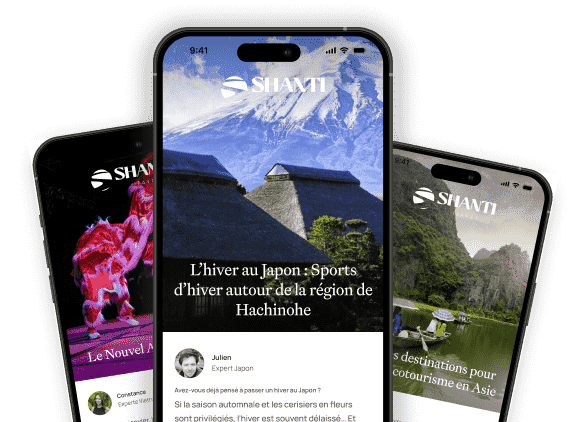

Subscribe and receive our travel inspirations and practical advice twice a month.

Wanting to share your trip with a group?
See our guaranteed departures
Travel to Indonesia to explore its remarkable geography and discover why this vast archipelago is a living testament to the power and beauty of Earth's natural forces.
The geography of Indonesia is among the most dramatic and diverse on Earth. Stretching across more than 17,000 islands and lying at the intersection of the Indian and Pacific Oceans, Indonesia is the world’s largest archipelagic country, a place where volcanoes, rainforests, coral reefs, beaches, and highlands come together in a vibrant natural mosaic. What sets Indonesia apart is its position atop four major tectonic plates—Eurasian, Indo-Australian, Pacific, and Philippine Sea plates—creating one of the world's most active seismic and volcanic zones.
Whether you're diving off the coast of Flores, hiking an active volcano in Java, or exploring rainforest sanctuaries in Borneo, Indonesia’s landscape is nothing short of extraordinary. Nowhere else does nature blend such lush biodiversity with raw geological energy.
Indonesia straddles the equator, geographically positioned between Southeast Asia and Oceania. It shares land borders with:
These borders, shaped by Dutch colonial history, define the modern Republic. In 1969, West Papua became part of Indonesia. In contrast, East Timor gained independence in 2002.
Travel tip: Visit Entikong for a glimpse of the Malaysia-Indonesia border, or trek to Jayapura, a highland gateway to Papua New Guinea.
Indonesia’s islands are grouped into three major regions:
1. The Sunda Islands
Split into:
Rich in geological wonders and cultural heritage, this is Indonesia’s most visited region.
Explore: Borobudur (Java), Lake Toba (Sumatra), Mount Rinjani (Lombok), Gili Islands (Lombok)
2. The Maluku Islands (Spice Islands): Famed for spices like nutmeg and cloves, these islands are steeped in colonial maritime history.
Explore: Banda Neira, Ternate, Ambon ideal for diving and cultural immersion
3. Papua (Western New Guinea): A remote frontier rich in tribal traditions and biodiversity.
Explore: Raja Ampat (pristine reefs), Baliem Valley (tribal culture), Wamena
With over 55,000 km of coastline, Indonesia is defined by its waters. The archipelago is bordered by the:
And contains major seas like the: Java Sea, Banda Sea, Flores Sea, Bali Sea, Timor Sea, Celebes Sea, and Arafura Sea.
Strategic straits such as the Malacca Strait and Makassar Strait are key to global trade and marine biodiversity. Indonesia's underwater geography is just as staggering, hosting the Weber Deep in the Banda Sea—one of the deepest oceanic points on earth—and some of the world’s most extensive coral reef systems.
Travel tip: Sail through the Flores Sea on a liveaboard cruise or dive into Bunaken Marine Park near Sulawesi to witness outstanding marine biodiversity.
Indonesia’s rugged terrain is shaped by its location on the Pacific Ring of Fire. With over 150 active volcanoes, it is one of the most seismically active countries in the world. Frequent earthquakes, volcanic eruptions, and geothermal hot springs are hallmarks of life here—fascinating for visitors and ever-present for locals.
The highest point: Puncak Jaya (4,884 m), Papua—one of the few equatorial glaciers in the world
Volcanic icons:
Travel tip: Trek to Mount Bromo at dawn or descend into Ijen’s crater for a surreal, glowing spectacle.
Owing to its immense east-west sprawl and varied elevation, Indonesia’s climate varies from equatorial rainforests to savannahs and alpine tundra, with tropical wet and dry monsoon seasons and countless microclimates—the coastlines experience pronounced humidity and rainfall, while highlands can be refreshingly cool.
Indonesia is a biogeographic marvel cleaved by the famed Wallace Line—a deep-water boundary that runs between Borneo and Sulawesi and between Bali and Lombok. West of this line, the flora and fauna are predominantly Asian, while eastwards, Australian influences dominate. The Wallacea region itself is a global hotspot of endemism, with species found nowhere else.
Indonesia is rich in natural resources and one of the world’s top biodiversity hotspots, second only to Brazil.
Key resources: Oil, natural gas, coal, gold, nickel, palm oil, rubber, tropical hardwoods
Biodiversity highlights:
Travel tip:
The fragmented landmass—over 17,000 islands—presents daily logistical challenges, especially for transport and connectivity. Many communities rely on small boats or domestic flights to move between islands. This natural separation has led to a tapestry of languages, ethnicities, and traditions—and also to unique local adaptations to climate and ecology.
For travelers, this means unparalleled diversity, but also the need for smart planning—at Shanti Travel, we build programs that weave together air, sea, and land routes to reveal the true richness of Indonesia’s geography.
Here's what makes each region of Indonesia unique:
Sumatra – UNESCO rainforests, volcanoes, wild orangutans: Bukit Lawang, Lake Toba, Mentawai Islands
Java – Cultural heartland, volcanoes, temples: Yogyakarta, Borobudur, Mount Bromo
Borneo (Kalimantan) – Jungle expeditions, river safaris: Camp Leakey, Sekonyer River
Bali – Temples, surfing, yoga retreats: Ubud, Mount Agung, Bratan Lake
Lombok – Hiking, Sasak culture, beaches: Mount Rinjani, Kuta Lombok
Flores & Komodo – Dragons, crater lakes, diving: Kelimutu, Labuan Bajo, Wae Rebo
Sulawesi – Marine biodiversity, Torajan culture: Tana Toraja, Lake Tempe, Manado
Papua – Tribal encounters, remote adventure: Raja Ampat, Jayapura, Baliem Valley
With its awe-inspiring landscapes, cultural diversity, and rich ecosystems, the geography of Indonesia is a dream for trekkers, divers, photographers, and nature lovers. Understanding the land’s tectonic, climatic, and ecological intricacies is the first step to crafting an unforgettable experience in Indonesia.
Get in touch with Alisha, your Indonesia Travel Expert
Let us craft your custom Indonesia itinerary built around the islands that inspire you most.

